
French postcard by Editions du Globe, no. 143. Photo: Sam Lévin.

British postcard by Picturegoer, London, no. W. 410. Photo: Columbia. Orson Welles in The Lady from Shanghai (Orson Welles, 1947).
His brashness and impassioned quality
George Orson Welles was born in Kenosha, Wisconsin, in 1915. He was the second son of Beatrice (née Ives) and Richard Hodgdon Head Welles. In 1919, his parents separated and moved to Chicago. His father, who made a fortune as the inventor of a popular bicycle lamp, became an alcoholic and stopped working. His brother ‘Dickie’ was institutionalised at an early age because he had learning difficulties.
Welles's mother, a beautiful concert pianist, had to support her son and herself. In 1924, Beatrice died of hepatitis in a Chicago hospital, just after Welles's ninth birthday. He was taken in by Dudley Crafts Watson. At the age of ten, Orson ran away from home with Watson's third daughter, Marjorie. They were found a week later, singing and dancing for money on a street corner in Milwaukee.
Welles' father died when Orson was 15. Maurice Bernstein, a physician from Chicago, became his guardian. His school teacher Roger Hill provided Welles with an ad hoc educational environment that proved invaluable to his creative experience, allowing Welles to perform and stage theatrical experiments and productions.
Welles was awarded a scholarship to Harvard University, but he chose to travel to Europe instead. In Ireland, he strode into the Gate Theatre in Dublin and claimed he was a Broadway star. The manager of Gate, Hilton Edwards, was impressed by his brashness and impassioned quality in his audition. Welles made his stage debut at the Gate in 1931, appearing in 'Jew Suss' as the Duke. He acted to great acclaim, word of which reached the United States.
On returning to the United States he wrote the immensely successful 'Everybody's Shakespeare'. In 1933, he toured in three off-Broadway productions with Katharine Cornell's company, including two roles in 'Romeo and Juliet'. In 1934, he shot his first film, an eight-minute short titled The Hearts of Age, and he married Chicago actress Virginia Nicholson. By 1935 Welles was supplementing his earnings in the theatre as a radio actor, working with many actors who would later form the core of his Mercury Theatre.

British postcard in the Picturegoer Series, London, no. W 130. Photo: RKO Radio.
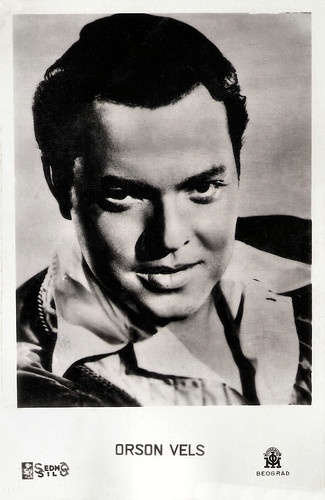
Yugoslavian postcard by Sedma Sila. Photo: IOM, Beograd. Orson Welles in Citizen Kane (Orson Welles, 1941). Caption: Orson Vels.
The Night That Panicked America
In 1936, the Federal Theatre Project (part of Roosevelt's Works Progress Administration) put unemployed theatre performers and employees to work. Orson Welles was hired by John Houseman and assigned to direct a play for the Federal Theatre Project's Negro Theatre Unit. His production of 'Macbeth' was set in the Haitian court of King Henri Christophe, with voodoo witch doctors for the three Weird Sisters. The play was received rapturously and later toured the nation.
At 20, Welles was hailed as a prodigy. A few minutes of Welles’ ‘Voodoo Macbeth’ was recorded on film in the documentary We Work Again (1937). Welles rehearsed Marc Blitzstein's political operetta, 'The Cradle Will Rock', but because of severe federal cutbacks in the Works Progress projects, the show's premiere at the Maxine Elliott Theatre was cancelled.
In a last-minute move, Welles announced to waiting ticket-holders that the show was being transferred to the Venice, twenty blocks away. Some cast, crew and audience members walked the distance on foot. Lacking the participation of the union members, 'The Cradle Will Rock' began with Blitzstein introducing the show and playing the piano accompaniment on stage with some cast members performing from the audience. This impromptu performance was well received and played at the Venice for two more weeks.
Welles and Houseman then formed the Mercury Theatre, of which Welles became the executive producer and whose repertory company eventually included the actors Agnes Moorehead, Joseph Cotten, Dolores del Río, Everett Sloane, and Erskine Sanford. The first Mercury Theatre production was William Shakespeare's tragedy 'Julius Caesar', set in a contemporary frame of fascist Italy. The production was widely acclaimed.
In the second year of the Mercury Theater, Welles shifted his interests to the radio. He adapted, directed and played 'Hamlet' for CBS and 'Les Misérables' for Mutual with great success. CBS gave the Mercury Theatre a weekly hour-long show to broadcast radio plays based on classic literary works. In 1938, their adaptation of 'The War of the Worlds' by H. G. Wells brought Welles instant fame. The combination of the news bulletin form of the performance with the between-breaks dial spinning habits of listeners from the rival more popular Edgar Bergen/Charlie McCarthy program was later reported in the media to have created widespread confusion.
Wikipedia: “Panic was reportedly spread among listeners who believed the news reports of a Martian invasion. The myth of the result created by the combination was reported as fact around the world and disparagingly mentioned by Adolf Hitler in a public speech some months later. The 1975 docudrama The Night That Panicked America was based on events centring on the production of, and events that resulted from the program.”

Vintage playcard. Photo: Ernest A. Bachrach. Orson Welles in Citizen Kane (Orson Welles, 1941).

Dutch postcard by S. & v. H. A. Photo: M.P.E.A. Loretta Young and Orson Welles in The Stranger (Orson Welles, 1946).
The attempted suppression of Citizen Kane
Orson Welles's growing fame drew Hollywood offers, lures that the independent-minded Welles resisted at first. RKO Radio Pictures president George Schaefer eventually offered him complete artistic control and signed Welles in a two-picture deal, although Welles had a budget limit for his projects. In Hollywood, Welles toyed with various ideas for his first project.
RKO rejected Welles's first two movie proposals but agreed on the third offer, Citizen Kane (1941), for which Welles co-wrote, produced, directed and performed the lead role. Co-scriptwriter Joseph Mankiewicz based the original outline on an exposé of the life of William Randolph Hearst, whom he knew socially and came to hate, having once been great friends with Hearst's mistress, Marion Davies.
Kane's megalomania was modelled loosely on Robert McCormick, Howard Hughes and Joseph Pulitzer as Welles wanted to create a broad, complex character, intending to show him in the same scenes from several points of view. On Welles's instruction, John Houseman wrote the opening narration as a pastiche of The March of Time newsreels. Autobiographical allusions to Welles were worked in, most noticeably in the treatment of Kane's childhood and particularly, regarding his guardianship.
Once the script was complete, Welles attracted cinematographer Gregg Toland, and actors from his Mercury Theatre. After gossip columnist Hedda Hopper saw a preview screening of Citizen Kane, the attempted suppression of Citizen Kane started. Hearst's media outlets boycotted the film. They exerted enormous pressure on Hollywood, but RKO gave the film a limited release.
The film was well-received critically and garnered nine Academy Award nominations. Welles was nominated as a producer, director, writer and actor, but won only for Best Original Screenplay, shared with Mankiewicz. Today, the film is considered by most film critics and historians to be one of the classics in film history.

Vintage postcard. Photo: Edward Cronenweth. Orson Welles and Rita Hayworth in The Lady From Shanghai (Orson Welles, 1947).

Vintage postcard. Photo: Columbia. Orson Welles in The Lady From Shanghai (Orson Welles, 1947).
A climactic confrontation scene in an amusement park funhouse
Orson Welles's second film for RKO was The Magnificent Ambersons (1942), adapted from the Pulitzer Prize-winning novel by Booth Tarkington. At RKO's request, Welles worked also on an adaptation of Eric Ambler's spy thriller, Journey into Fear (Norman Foster, 1943), co-written with Joseph Cotten. In addition to acting in the film, Welles was the producer.
Changes throughout RKO caused re-evaluations of both projects. RKO took control of The Magnificent Ambersons and ordered to edit the film into a ‘commercial’ format. They removed fifty minutes of Welles's footage, re-shot sequences, rearranged the scene order, and added a happy ending. It resulted in an expensive flop for RKO, although The Magnificent Ambersons received four Academy Award nominations including Best Picture and Best Supporting Actress for Agnes Moorehead.
Welles found no studios interested in him as a director after the disaster of The Magnificent Ambersons and worked on radio. In 1943, he married Rita Hayworth. They had one child, Rebecca Welles, and divorced five years later in 1948. In between, Welles found work as an actor in other films. He starred in the film adaptation of Jane Eyre (Robert Stevenson, 1944), trading credit as associate producer for top billing over Joan Fontaine. He had a cameo in the wartime salute Follow the Boys (A. Edward Sutherland, 1944), in which he performed his magic act ‘sawing’ Marlene Dietrich in half.
In 1946, Sam Spiegel produced The Stranger (Orson Welles, 1946), starring Edward G. Robinson, Loretta Young and Welles. The film follows the hunt for a Nazi war criminal living under an alias in the United States. Although disputes occurred during editing between Spiegel and Welles, the film was a box office success and it helped his standing with the studios.
He then filmed The Lady from Shanghai (Orson Welles, 1947) for Columbia Pictures, in which his then-estranged second wife Rita Hayworth co-starred. Cohn disliked Welles's rough-cut and ordered extensive editing and re-shoots. Approximately one hour of Welles's first cut was removed, including much of a climactic confrontation scene in an amusement park funhouse. The film was considered a disaster in America at the time of release, though the closing shootout in a hall of mirrors has since become a touchstone of Film Noir.
Welles convinced Republic Pictures to let him direct a low-budget version of Macbeth (Orson Welles, 1948). Republic initially trumpeted the film as an important work but decided it did not care for the Scottish accents and held up general release for almost a year after the early negative press reaction. In the late 1970s, a fully restored version of Macbeth was released that followed Welles's original vision.

Belgian postcard by International Lotto Club, Monte-Carlo.

Vintage card. Photo: Columbia.
An international smash hit
Orson Welles left Hollywood for Europe. In Italy, he starred as Cagliostro in Black Magic (Gregory Ratoff, 1948) with Akim Tamiroff. His co-star impressed Welles so much that Tamiroff would appear in four of Welles's later productions. Welles starred as Harry Lime in Carol Reed's The Third Man (1949), alongside Joseph Cotten. The film was an international smash hit.
Welles also appeared as Cesare Borgia in the Italian film Prince of Foxes (Henry King, 1949), and as the Mongol warrior Bayan in The Black Rose (Henry Hathaway, 1950), both with Tyrone Power. Welles was channelling his money from acting jobs into a self-financed film version of Shakespeare's play Othello. From 1949 to 1951, Welles filmed Othello (1952) on location in Europe and Morocco. Suzanne Cloutier co-starred as Desdemona. When it premiered at the Cannes Film Festival it won the Palme d'Or, but the film did not receive a general release in the United States until 1955.
Welles's daughter, Beatrice Welles-Smith, restored Othello in 1992 for a wide re-release. Welles played the murdered victim in Trent's Last Case (Herbert Wilcox, 1952) and the title role in the 'Lord Mountdrago' segment of Three Cases of Murder (George More O'Ferrall, 1954). Herbert Wilcox cast Welles as the antagonist in Trouble in the Glen (1954) opposite Margaret Lockwood, and John Huston cast him as Father Mapple in Moby-Dick (1956), starring Gregory Peck.
Welles's next turn as director was Mr. Arkadin (Orson Welles, 1955), filmed in France, Germany, Spain and Italy on a very limited budget. Welles played a billionaire who hires a man (Robert Arden) to delve into the secrets of his past. The film co-starred Welles's third wife, Paola Mori. Frustrated by his slow progress in the editing room, producer Louis Dolivet removed Welles from the project and finished the film without him as Confidential Report.
In 1956, Welles returned to Hollywood and guest-starred on radio and television shows. His next film role was in Man in the Shadow (Jack Arnold, 1957) for Universal Pictures, starring Jeff Chandler. Around this time period, Welles began to suffer from weight problems that would eventually cause a deterioration in his health.
Welles stayed on at Universal to co-star with Charlton Heston in Touch of Evil (Orson Welles, 1958). Originally only hired as an actor, Welles was promoted to director by Universal at the insistence of Heston. He reunited with many actors and technicians with whom he had worked in the 1940s including Joseph Cotten, Marlene Dietrich and Akim Tamiroff. Filming proceeded smoothly, but after the end of production, the studio re-edited the film, re-shot scenes, and shot new exposition scenes to clarify the plot. In 1978, a longer preview version of the film was discovered and released.
Next, Welles filmed his adaptation of Miguel de Cervantes' novel 'Don Quixote in Mexico' starring Mischa Auer as Quixote and Akim Tamiroff as Sancho Panza. While filming would continue in fits and starts for several years, Welles would never complete the project. Welles continued acting, notably in The Long, Hot Summer (Marin Ritt, 1958) and Compulsion (Richard Fleischer, 1959), but soon he returned to Europe.

Big programme card by Cineteca Bologna for Il Cinema Ritrovato, XXXVI edizione, Selezione Cinema Ritrovato Young, 30 June 2022. Pierr Paolo Pasolini and Orson Welles on the set of La Ricotta (Pier Paolo Pasolini, 1963).La Ricotta was an episode of the anthology film Ep.di.Ro.Go.Pa.G. (1963).
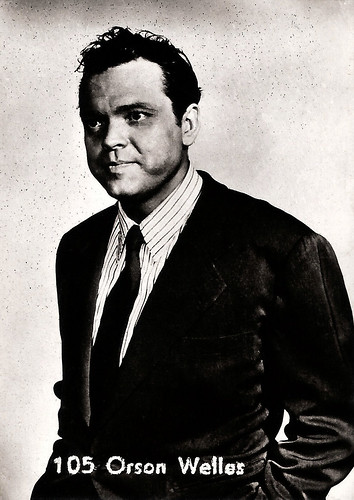
Small Belgian collectors card by Belgian Chewing Gum Ltd., Antwerp, no. 105.
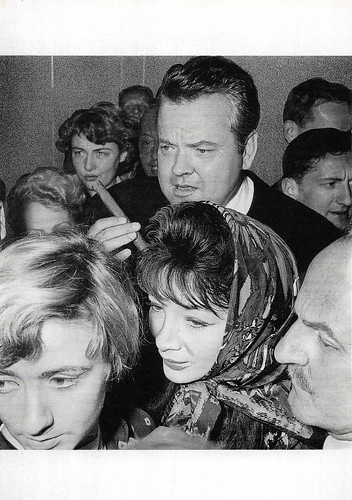
French postcard in the Collection Cinéma by Editions La Malibran, Paris, 1990, no. CF 69. Caption: Orson Welles - Françoise Sagan - Juliette Greco - Daryl Zanuck - Mai 59. On 5 May 1959, Orson Welles was photographed at the Cannes Film Festival with Francoise Sagan, Darryl F. Zanuck and Juliette Greco. Orson Welles's shown film Compulsion' (Richard Fleischers, 1959) scored a great success. Francoise Sagan was said to be negotiating with Zanuck and Welles for a film based on one of her latest novels.
Kafka
In Italy, Orson Welles directed his own scenes as King Saul in David e Golia/David and Goliath (Ferdinando Baldi, Richard Pottier, 1959). In Hong Kong, he co-starred with Curt Jürgens in Ferry to Hong Kong (Lewis Gilbert, 1959). In Paris, he co-starred in Crack in the Mirror (Richard Fleischer, 1960). In Yugoslavia, he starred in I tartari/The Tartars (Richard Thorpe, 1962) and Bitka na Neretvi/Battle of Neretva (Veljko Bulajić, 1969).
In 1962, Welles directed Le Procès/The Trial (Orson Welles, 1962), based on the novel by Franz Kafka and starring Anthony Perkins as Josef K, Jeanne Moreau and Romy Schneider. The film failed at the box office, but during the filming, he met Oja Kodar, who became his muse, star and mistress for the rest of his life.
Welles played a film director in La Ricotta (1963), Pier Paolo Pasolini's segment of the anthology film Ro.Go.Pa.G. He continued taking what work he could find acting, narrating or hosting other people's work, and began filming Campanadas a medianoche/Chimes at Midnight (Orson Welles, 1966). Filmed in Spain, it was a condensation of five Shakespeare plays, telling the story of Falstaff (Welles) and his relationship with Prince Hal (Keith Baxter).
Then followed Histoire immortelle/The Immortal Story (Orson Welles, 1968) with Jeanne Moreau, which had a successful run in French theatres. He appeared as Cardinal Wolsey in A Man for All Seasons (Fred Zinnemann, 1966) for which he won considerable acclaim. Welles began directing The Deep, based on the novel 'Dead Calm' by Charles Williams and filmed off the shore of Yugoslavia. The cast included Jeanne Moreau, Laurence Harvey and Oja Kodar.
Personally financed by Welles and Kodar, they could not obtain the funds to complete the project, and it was abandoned a few years later after the death of Harvey. The surviving footage was eventually edited and released by the Filmmuseum München. In 1969, Welles played a supporting role in John Huston's The Kremlin Letter. Drawn by the numerous offers he received to work in television and films, and upset by a tabloid scandal reporting his affair with Kodar, Welles moved back to America in 1970.

Romanian postcard by Casa Filmului Acin, no. 470. Photo: Elsa Martinelli and Anthony Perkins in Le procès/The Trial (Orson Welles, 1962). Sent by mail in 1972.

French postcard by Editions F. Nugeron, no. Star 130. Photo: Air France / Distribution VU. Caption: Orson Wells (sic), Septembre 1967.
The Dreamers
In Hollywood, Orson Welles continued to self-finance his own film and television projects. While offers to act, narrate and host continued, Welles also found himself in great demand on television talk shows. His primary focus during his final years was The Other Side of the Wind, an unfinished project that was filmed intermittently between 1970 and 1976. Written by Welles, it is the story of an ageing film director (John Huston) looking for funds to complete his final film. Financed by Iranian backers, ownership of the film fell into a legal quagmire after the Shah of Iran was deposed, and disputes still prevent its release.
Welles portrayed Louis XVIII of France in Waterloo (Sergey Bondarchuk, 1970), and narrated the historical comedy Start the Revolution Without Me (Bud Yorkin, 1970). He appeared in La décade prodigieuse/Ten Days' Wonder (Claude Chabrol, 1971), co-starring with Anthony Perkins. Wikipedia: “That same year, the Academy of Motion Picture Arts and Sciences gave him an honorary award "For superlative artistry and versatility in the creation of motion pictures". Welles pretended to be out of town and sent John Huston to claim the award. Huston criticised the Academy for awarding Welles, even while they refused to give Welles any work.”
Welles played Long John Silver in Treasure Island (John Hough, 1972), an adaptation of the Robert Louis Stevenson novel. He completed F for Fake (Orson Welles, 1973), a personal essay film about art forger Elmyr de Hory and the biographer Clifford Irving, and his documentary Filming Othello (Orson Welles, 1979).
During the 1980s, Welles worked on such film projects as The Dreamers, based on two stories by Isak Dinesen. His last film appearance was in Henry Jaglom's Someone to Love (1987), released after his death.
Welles had three daughters: Chris Welles Feder (1938), with Virginia Nicholson; Rebecca Welles Manning (1944–2004), with Rita Hayworth; and Beatrice Welles (1955), with Paola Mori. His only known son, British director Michael Lindsay-Hogg (1940), is from Welles's affair with Irish actress Geraldine Fitzgerald, then the wife of Sir Edward Lindsay-Hogg, 4th baronet.
On 10 October 1985, Orson Welles appeared in his final interview on The Merv Griffin Show. He died several hours later of a heart attack at his home in Los Angeles. His estranged wife Paola Mori refused to allow most of Welles's friends to attend the funeral, limiting the mourners to just nine: herself, Welles's three daughters, Roger Hill, and three of Welles's friends, as well as the doctor who had signed Welles's death certificate.
Welles's companion for the last 20 years, Oja Kodar, was not invited, nor were either of his ex-wives. Welles's ashes were taken to Ronda, Spain, where they were buried in an old well covered by flowers, within the rural property of a long-time friend, retired bullfighter Antonio Ordóñez.
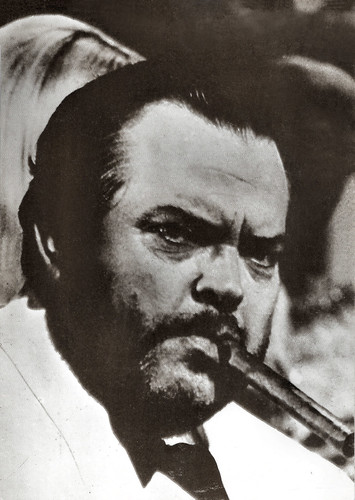
French postcard by Delta Productions, Montpellier, no. CP152. Orson Welles in Casino Royale (Val Guest, Ken Hughes, John Huston, 1967).
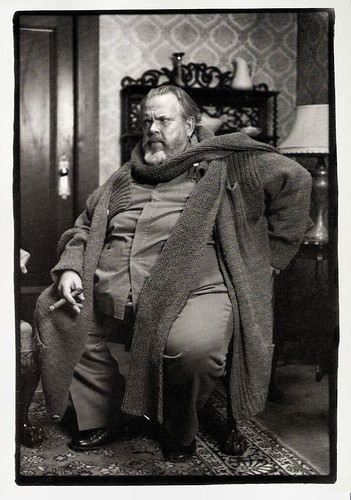
American postcard by Fotofolio, New York, N.Y., no. P27. Photo: Timothy Greenfield-Sanders. Caption: Orson Welles, 1979.
Sources: Ed Stephan (IMDb), Wikipedia, and IMDb.
No comments:
Post a Comment